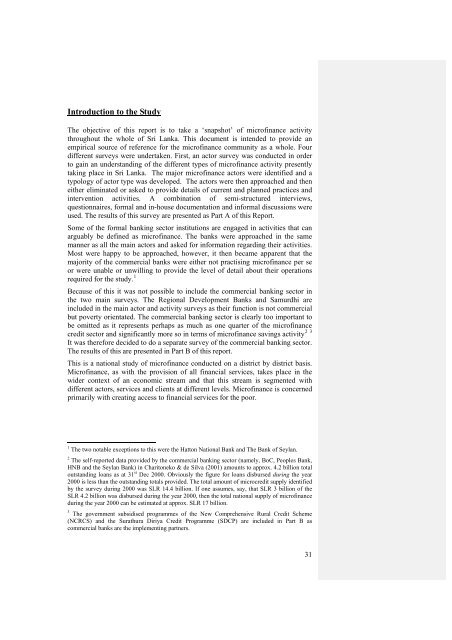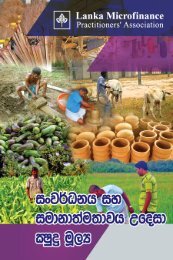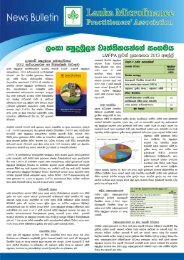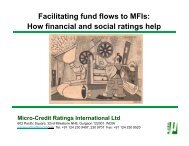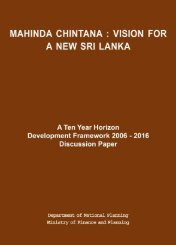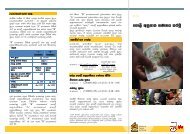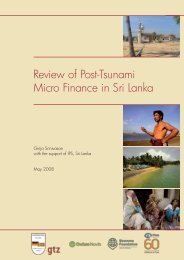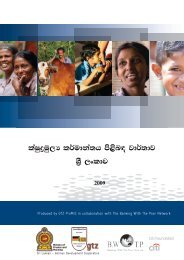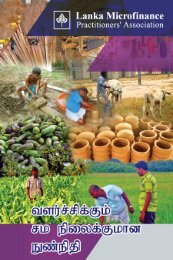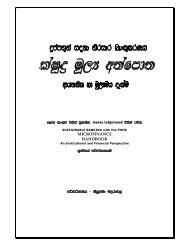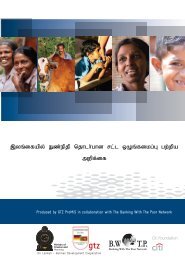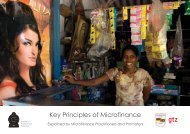National Microfinance Study of Sri Lanka: Survey of Practices and ...
National Microfinance Study of Sri Lanka: Survey of Practices and ...
National Microfinance Study of Sri Lanka: Survey of Practices and ...
Create successful ePaper yourself
Turn your PDF publications into a flip-book with our unique Google optimized e-Paper software.
Introduction to the <strong>Study</strong><br />
The objective <strong>of</strong> this report is to take a ‘snapshot’ <strong>of</strong> micr<strong>of</strong>inance activity<br />
throughout the whole <strong>of</strong> <strong>Sri</strong> <strong>Lanka</strong>. This document is intended to provide an<br />
empirical source <strong>of</strong> reference for the micr<strong>of</strong>inance community as a whole. Four<br />
different surveys were undertaken. First, an actor survey was conducted in order<br />
to gain an underst<strong>and</strong>ing <strong>of</strong> the different types <strong>of</strong> micr<strong>of</strong>inance activity presently<br />
taking place in <strong>Sri</strong> <strong>Lanka</strong>. The major micr<strong>of</strong>inance actors were identified <strong>and</strong> a<br />
typology <strong>of</strong> actor type was developed. The actors were then approached <strong>and</strong> then<br />
either eliminated or asked to provide details <strong>of</strong> current <strong>and</strong> planned practices <strong>and</strong><br />
intervention activities. A combination <strong>of</strong> semi-structured interviews,<br />
questionnaires, formal <strong>and</strong> in-house documentation <strong>and</strong> informal discussions were<br />
used. The results <strong>of</strong> this survey are presented as Part A <strong>of</strong> this Report.<br />
Some <strong>of</strong> the formal banking sector institutions are engaged in activities that can<br />
arguably be defined as micr<strong>of</strong>inance. The banks were approached in the same<br />
manner as all the main actors <strong>and</strong> asked for information regarding their activities.<br />
Most were happy to be approached, however, it then became apparent that the<br />
majority <strong>of</strong> the commercial banks were either not practising micr<strong>of</strong>inance per se<br />
or were unable or unwilling to provide the level <strong>of</strong> detail about their operations<br />
required for the study. 1<br />
Because <strong>of</strong> this it was not possible to include the commercial banking sector in<br />
the two main surveys. The Regional Development Banks <strong>and</strong> Samurdhi are<br />
included in the main actor <strong>and</strong> activity surveys as their function is not commercial<br />
but poverty orientated. The commercial banking sector is clearly too important to<br />
be omitted as it represents perhaps as much as one quarter <strong>of</strong> the micr<strong>of</strong>inance<br />
credit sector <strong>and</strong> significantly more so in terms <strong>of</strong> micr<strong>of</strong>inance savings activity 2 3<br />
It was therefore decided to do a separate survey <strong>of</strong> the commercial banking sector.<br />
The results <strong>of</strong> this are presented in Part B <strong>of</strong> this report.<br />
This is a national study <strong>of</strong> micr<strong>of</strong>inance conducted on a district by district basis.<br />
<strong>Micr<strong>of</strong>inance</strong>, as with the provision <strong>of</strong> all financial services, takes place in the<br />
wider context <strong>of</strong> an economic stream <strong>and</strong> that this stream is segmented with<br />
different actors, services <strong>and</strong> clients at different levels. <strong>Micr<strong>of</strong>inance</strong> is concerned<br />
primarily with creating access to financial services for the poor.<br />
1 The two notable exceptions to this were the Hatton <strong>National</strong> Bank <strong>and</strong> The Bank <strong>of</strong> Seylan.<br />
2 The self-reported data provided by the commercial banking sector (namely, BoC, Peoples Bank,<br />
HNB <strong>and</strong> the Seylan Bank) in Charitoneko & de Silva (2001) amounts to approx. 4.2 billion total<br />
outst<strong>and</strong>ing loans as at 31 st Dec 2000. Obviously the figure for loans disbursed during the year<br />
2000 is less than the outst<strong>and</strong>ing totals provided. The total amount <strong>of</strong> microcredit supply identified<br />
by the survey during 2000 was SLR 14.4 billion. If one assumes, say, that SLR 3 billion <strong>of</strong> the<br />
SLR 4.2 billion was disbursed during the year 2000, then the total national supply <strong>of</strong> micr<strong>of</strong>inance<br />
during the year 2000 can be estimated at approx. SLR 17 billion.<br />
3 The government subsidised programmes <strong>of</strong> the New Comprehensive Rural Credit Scheme<br />
(NCRCS) <strong>and</strong> the Surathura Diriya Credit Programme (SDCP) are included in Part B as<br />
commercial banks are the implementing partners.<br />
31


